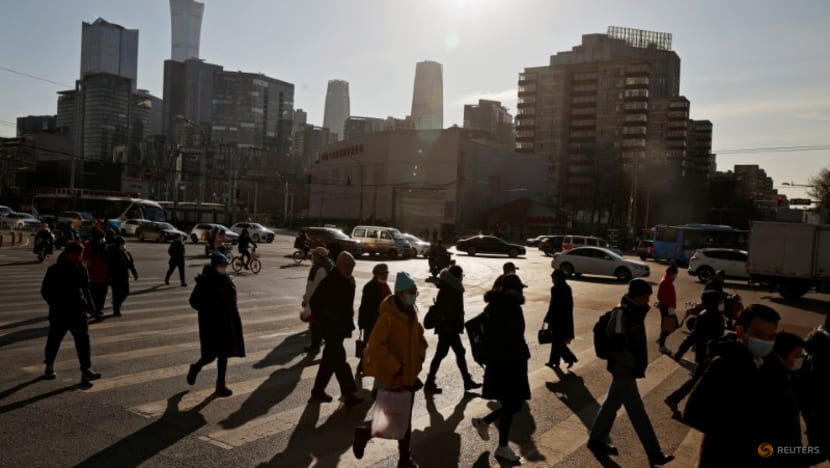China is trying to revive its economy. Is it too little, too late?
The world's second-largest economy posted its slowest growth since early 2023 in the third quarter, according to data released on Friday.

People cross a street during morning rush hour in front of the skyline of the Central Business District (CBD) in Beijing, China on Dec 15, 2020. (File photo: REUTERS/Thomas Peter)

This audio is generated by an AI tool.
China’s lacklustre economic growth underscores the urgent need for policymakers to move quickly with aggressive stimulus measures to reignite its economy, said analysts at the FutureChina Global Forum held in Singapore on Friday (Oct 18).
The world's second-largest economy posted its slowest growth in one-and-a-half years, according to data released on Friday.
The National Bureau of Statistics (NBS) said the economy expanded 4.6 per cent year on year in the third quarter, below the 4.7 per cent pace in the previous quarter.
It highlighted a “complicated and severe external environment ... as well as new problems of domestic economic development”.
SOME POSITIVE SIGNS
Some observers believe the latest data means China’s full-year growth target of around 5 per cent in 2024 will be tough to meet.
They hope the latest performance, which was largely expected, will spur policymakers to step up efforts to get its economy back on track as the year-end draws nearer.
A major drag on China’s economy has been its tumbling housing market. The beleaguered sector is undergoing a rebalancing phase between supply and demand.
“One of the key challenges right now is how China is going to rebalance the supply and the demand,” said Tommy Xie, head of Asia Macro Research at OCBC.
“It seems like it'll still take some time, maybe another half year to one year … But in the near term, I guess the market will still face quite a number of challenges.”
Still, there were some positive signs from the new NBS data.
While China’s property woes continue, retail sales - a gauge of consumer spending - and industrial output for September grew.
Industrial output in September rose 5.4 per cent from a year earlier, up from a 4.5 per cent pace in August. Retail sales went up 3.2 per cent in September, accelerating from a 2.1 per cent growth the month before.
“I think some of the details are still quite encouraging,” Xie told CNA’s Asia Now.
“Overall, I think we are seeing resilience in external demand, (and) we are starting to see maybe some kind of a pick-up of domestic demand. So that should be good news for China to see those numbers.”
On whether China’s economy remains in an emergency mode, as some analysts have suggested, economist David Li Daokui – who is a former adviser of the People's Bank of China, the country's central bank – said it is “a situation of great concern”.
“The big concern is whether the momentum of the sliding down of the economy will be reversed,” he told CNA’s Asia First on the sidelines of the bilingual forum on China and the region.
REVIVING THE ECONOMY
Since last month, the authorities have rolled out a slew of measures to stimulate sluggish consumption and address a prolonged debt crisis in the struggling property sector. This includes increased funding, interest rate cuts, and efforts to ease mortgage repayment burdens.
On whether the measures are too little, too late, Li said economists have been arguing for major policy adjustments for more than a year.
The director of Tsinghua University’s Academic Center for Chinese Economic Practice and Thinking noted: “Finally, they are making adjustments.
“I wouldn't say too late, but I would argue that it should be more. It's not late, but (they have to) push it hard.”
Li said the most important stimulus measure would be a large-scale debt swap programme that allows provincial-level governments to replace so-called hidden debt – borrowing through companies and other financing vehicles – with new official bonds carrying lower interest rates.
“Local governments are now shrinking because they are pushed to pay back their debt,” he added.
“They simply cannot service the debt, let alone pay back the debt. So local governments in turn are squeezing some of their employees, delaying their welfare or bonus payments, while squeezing their suppliers and delaying payments.”
For now, market watchers are looking forward to the meeting of the Standing Committee of the National People's Congress, China's top legislative body, later this month for more details.
“I think the market is still waiting for the details, but of course one more thing we can hope to see is more measures to support domestic demand, in particular consumption,” said Xie.
“There's a lot of measures to deal with the hidden debt by the local governments. We are seeing a lot of measures to safeguard financial risk, but not much on the domestic demand part. So this is something I think hopefully we can see more in the coming months and the quarters.”















